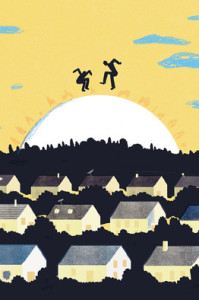WSJ Historically Speaking: The Bad Idea of Daylight-Saving Time
Every November, a great theft is perpetrated against hundreds of millions of innocent people. They are robbed of an hour of afternoon sunlight by the government decree that divides the year into standard and daylight-saving time. The switch to standard time occurs precisely at the wrong moment, when the days are already growing shorter.
The arguments used to justify the DST arrangement always employ the language of cost, savings and safety. But, as the Canadian novelist Robertson Davies once observed: “At the back of the Daylight Saving scheme I detect the bony, blue-fingered hand of Puritanism, eager to push people into bed earlier, and get them up earlier, to make them healthy, wealthy and wise in spite of themselves.”
It was in the 14th century that humanity was liberated from relying on the sun or water for telling the time. In place of sundials and water clocks came the wonder of mechanical devices that worked independently of cloudy days and freezing weather.
The oldest working clock in the world is said to be the hourly clock in Salisbury Cathedral in the west of England. Designed in 1386 to strike a single bell on the hour every hour, it was built with one purpose in mind: to bring people closer to God by reminding them of service times. For the medieval peasant and noble alike, time wasn’t the handmaiden of money but an expression of religious faith.
According to the late British historian E.P. Thompson, it took less than 300 years for the process of time measurement to become an instrument of time management. Workers were conditioned to a life of chronological obedience long before the Lowell Mill Girls of Massachusetts exemplified the power of the factory revolution. By 1700 we had already entered, in Thompson’s words, “the familiar landscape of disciplined industrial capitalism, with the time-sheet, the timekeeper, the informers, and fines.”
The fathers of modern timekeeping had little notion that they were creating a monstrous highway to Mammon, just as Benjamin Franklin had no idea of the government oppression he was unleashing on his fellow brethren when he penned his humorous 1784 essay “An Economical Project for Diminishing the Cost of Light” for the Journal de Paris. Franklin was (perhaps) making a practical point about the advantages of daylight, but he was also poking fun at the French love of central bureaucracy. Franklin jokingly proposed that Parisians be subjected to a series of draconian measures to “encourage” them to live according to his daylight saving plan. This included a curfew after sundown and having guards placed at every candle shop to limit how much light a family was entitled to consume.
Unfortunately, Franklin’s jest became an obsession for a tiny handful of enthusiasts who gradually persuaded their governments that time could be their tool, to wield against their citizens as they saw fit. The Germans, Russians and Americans instituted DST during World War I as a means of conserving coal. The idea returned in World War II, when President Roosevelt instituted DST all year-round, calling it “Wartime.” After the war, Americans lived free of horological tyranny until Congress voted in the Uniform Time Act of 1966.
“So let us go on,” writes the poet Mary Oliver, in “Lines Written in the Days of Growing Darkness”: “though the sun be swinging east, and the ponds be cold and black, and the sweets of the year be doomed.” Would it were that easy, when the faceless system that determines our taxes also decides how much daylight we are allowed and when we may enjoy it. Yet the citizens of more than 160 countries, along with Hawaii and most of Arizona, still live unyoked to DST.
As the sun begins to set at 3 p.m., remember this isn’t Mother Nature at work but The Man.

